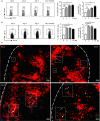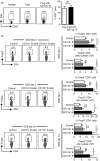Peyer's patches-derived CD11b+ B cells recruit regulatory T cells through CXCL9 in dextran sulphate sodium-induced colitis
- PMID: 29969845
- PMCID: PMC6187209
- DOI: 10.1111/imm.12977
Peyer's patches-derived CD11b+ B cells recruit regulatory T cells through CXCL9 in dextran sulphate sodium-induced colitis
Abstract
Regulatory T (Treg) cells play an essential role in the maintenance of intestinal homeostasis. In Peyer's patches (PPs), which comprise the most important IgA induction site in the gut-associated lymphoid tissue, Treg cells promote IgA isotype switching. However, the mechanisms underlying their entry into PPs and isotype switching facilitation in activated B cells remain unknown. This study, based on the dextran sulphate sodium (DSS)-induced colitis model, revealed that Treg cells are significantly increased in PPs, along with CD11b+ B-cell induction. Immunofluorescence staining showed that infiltrated Treg cells were located around CD11b+ B cells and produced transforming growth factor-β, thereby inducing IgA+ B cells. Furthermore, in vivo and in vitro studies revealed that CD11b+ B cells in PPs had the capacity to recruit Treg cells into PPs rather than promoting their proliferation. Finally, we found that Treg cell recruitment was mediated by the chemokine CXCL9 derived from CD11b+ B cells in PPs. These findings demonstrate that CD11b+ B cells induced in PPs during colitis actively recruit Treg cells to accomplish IgA isotype switch in a CXCL9-dependent manner.
Keywords: CD11b+ B cells; colitis; regulatory T cells.
© 2018 John Wiley & Sons Ltd.
Figures




Similar articles
-
Intestinal CD11b+ B Cells Ameliorate Colitis by Secreting Immunoglobulin A.Front Immunol. 2021 Nov 3;12:697725. doi: 10.3389/fimmu.2021.697725. eCollection 2021. Front Immunol. 2021. PMID: 34804004 Free PMC article.
-
T regulatory cells and B cells cooperate to form a regulatory loop that maintains gut homeostasis and suppresses dextran sulfate sodium-induced colitis.Mucosal Immunol. 2015 Nov;8(6):1297-312. doi: 10.1038/mi.2015.20. Epub 2015 Mar 25. Mucosal Immunol. 2015. PMID: 25807185 Free PMC article.
-
STAT6 Pathway Is Critical for the Induction and Function of Regulatory T Cells Induced by Mucosal B Cells.Front Immunol. 2021 Jan 29;11:615868. doi: 10.3389/fimmu.2020.615868. eCollection 2020. Front Immunol. 2021. PMID: 33584704 Free PMC article.
-
Peyer's patches: organizing B-cell responses at the intestinal frontier.Immunol Rev. 2016 May;271(1):230-45. doi: 10.1111/imr.12400. Immunol Rev. 2016. PMID: 27088918 Free PMC article. Review.
-
IL-21: a new player in the control of isotype switch in Peyer's patches.J Leukoc Biol. 2009 May;85(5):739-43. doi: 10.1189/jlb.0109045. J Leukoc Biol. 2009. PMID: 19406834 Review.
Cited by
-
Interleukin-35 -producing B cells rescues inflammatory bowel disease in a mouse model via STAT3 phosphorylation and intestinal microbiota modification.Cell Death Discov. 2023 Feb 17;9(1):67. doi: 10.1038/s41420-023-01366-5. Cell Death Discov. 2023. PMID: 36797242 Free PMC article.
-
Intestinal CD11b+ B Cells Ameliorate Colitis by Secreting Immunoglobulin A.Front Immunol. 2021 Nov 3;12:697725. doi: 10.3389/fimmu.2021.697725. eCollection 2021. Front Immunol. 2021. PMID: 34804004 Free PMC article.
-
Hypoxia/HIF Modulates Immune Responses.Biomedicines. 2021 Mar 5;9(3):260. doi: 10.3390/biomedicines9030260. Biomedicines. 2021. PMID: 33808042 Free PMC article. Review.
-
The effect of inulin-type fructans on the intestinal immune function of antibiotic-treated mice.Appl Microbiol Biotechnol. 2022 Apr;106(8):3265-3278. doi: 10.1007/s00253-022-11896-0. Epub 2022 Apr 4. Appl Microbiol Biotechnol. 2022. PMID: 35376973
-
Immune Microenvironment: New Insight for Familial Adenomatous Polyposis.Front Oncol. 2021 Feb 8;11:570241. doi: 10.3389/fonc.2021.570241. eCollection 2021. Front Oncol. 2021. PMID: 33628741 Free PMC article. Review.
References
-
- Mauri C, Bosma A. Immune regulatory function of B cells. Annu Rev Immunol 2012; 30:221–41. - PubMed
-
- Bouaziz JD, Yanaba K, Tedder TF. Regulatory B cells as inhibitors of immune responses and inflammation. Immunol Rev 2008; 224:201–14. - PubMed
-
- Kawamoto S, Maruya M, Kato LM, Suda W, Atarashi K, Doi Y et al Foxp3+ T cells regulate immunoglobulin a selection and facilitate diversification of bacterial species responsible for immune homeostasis. Immunity 2014; 41:152–65. - PubMed
Publication types
MeSH terms
Substances
LinkOut - more resources
Full Text Sources
Other Literature Sources
Molecular Biology Databases
Research Materials
Miscellaneous

